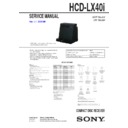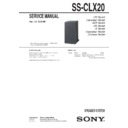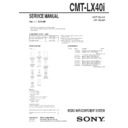Sony CMT-LX40I / HCD-LX40I Service Manual ▷ View online
SERVICE MANUAL
Sony Corporation
Audio&Video Business Group
Published by Sony Techno Create Corporation
HCD-LX40i
SPECIFICATIONS
COMPACT DISC RECEIVER
9-889-482-02
2009H05-1
©
2009.08
AEP Model
UK Model
Ver. 1.1 2009.08
• HCD-LX40i is the amplifi er, CD player, tuner
and iPod section in CMT-LX40i.
section
DIN power output (rated):
4 + 4 watts (4 ohms at 1 kHz, DIN)
Continuous RMS power output (reference): 5 + 5 watts (4 ohms at 1 kHz,
10% THD)
Music power output (reference): 9 + 9 watts
4 + 4 watts (4 ohms at 1 kHz, DIN)
Continuous RMS power output (reference): 5 + 5 watts (4 ohms at 1 kHz,
10% THD)
Music power output (reference): 9 + 9 watts
Inputs
AUDIO IN (stereo mini jack): Voltage 775 mV, impedance 22 kilohms
Outputs
PHONES (stereo mini jack): accepts headphones with an impedance of
8 ohms or more
SPEAKER: accepts impedance of 4 ohms
8 ohms or more
SPEAKER: accepts impedance of 4 ohms
CD player section
System: Compact disc and digital audio system
Laser Diode Properties
System: Compact disc and digital audio system
Laser Diode Properties
Emission Duration: Continuous
Laser Output*: Less than 44.6μW
*
Laser Output*: Less than 44.6μW
*
objective lens surface on the Optical Pick-up Block with 7mm aperture.
Frequency response: 20 Hz — 20 kHz
Signal-to-noise ratio: More than 90 dB
Dynamic range: More than 90 dB
Signal-to-noise ratio: More than 90 dB
Dynamic range: More than 90 dB
Tuner section
DAB tuner section
DAB tuner section
Frequency range*
Band-III: 174.928 (5A) — 239.200 (13F) MHz
* For details, see “DAB frequency table” below.
Antenna: DAB lead antenna
Antenna terminal: 75 ohms, F female
Band-III: 174.928 (5A) — 239.200 (13F) MHz
* For details, see “DAB frequency table” below.
Antenna: DAB lead antenna
Antenna terminal: 75 ohms, F female
DAB frequency table (Band-III)
Frequency
Label
Frequency
Label
174.928 MHz
5A
209.936 MHz
10A
176.640 MHz
5B
211.648 MHz
10B
178.352 MHz
5C
213.360 MHz
10C
180.064 MHz
5D
215.072 MHz
10D
181.936 MHz
6A
216.928 MHz
11A
183.648 MHz
6B
218.640 MHz
11B
185.360 MHz
6C
220.352 MHz
11C
187.072 MHz
6D
222.064 MHz
11D
188.928 MHz
7A
223.936 MHz
12A
190.640 MHz
7B
225.648 MHz
12B
192.352 MHz
7C
227.360 MHz
12C
194.064 MHz
7D
229.072 MHz
12D
195.936 MHz
8A
230.784 MHz
13A
197.648 MHz
8B
232.496 MHz
13B
199.360 MHz
8C
234.208 MHz
13C
201.072 MHz
8D
235.776 MHz
13D
202.928 MHz
9A
237.488 MHz
13E
204.640 MHz
9B
239.200 MHz
13F
206.352 MHz
9C
208.064 MHz
9D
* Frequencies are displayed to two decimal places on this system.
FM stereo, FM/AM superheterodyne tuner
FM tuner section:
FM tuner section:
Tuning range:
87.5 — 108.0 MHz (50 kHz step)
Antenna: FM lead antenna
Intermediate frequency: 10.7 MHz
Intermediate frequency: 10.7 MHz
AM tuner section:
Tuning range:
531 — 1,602 kHz (9 kHz step)
Antenna: AM loop antenna
Intermediate frequency: 450 kHz
531 — 1,602 kHz (9 kHz step)
Antenna: AM loop antenna
Intermediate frequency: 450 kHz
iPod section
Compatible iPod models:
Compatible iPod models:
iPod touch 2nd
generation
iPod nano 4th
generation
(video)
iPod touch 1st
generation
iPod nano 3rd
generation
(video)
iPod classic
iPod nano 2nd
generation
(aluminum)
iPod 5th
generation
(video)
iPod nano 1st
generation
iPod 4th
generation
(color display)
iPod 4th
generation
iPod mini
General
Power requirements:
230 V AC, 50/60 Hz
Power consumption: 25 watts
Dimensions (w/h/d) (excl. speakers): Approx. 200 × 221 × 205 mm
Mass (excl. speakers): Approx. 2.2 kg
Dimensions (w/h/d) (excl. speakers): Approx. 200 × 221 × 205 mm
Mass (excl. speakers): Approx. 2.2 kg
boards.
t iPod is a trademark of Apple Inc., registered in the U.S.
and other countries.
t MPEG Layer-3 audio coding technology and patents
t All other trademarks and registered trademarks are of
their respective holders. In this manual,
TM
and
®
marks
Model Name Using Similar Mechanism
NEW
CD Mechanism Type
CDM80BT-F4BD94-WOD
Base Unit Name
BU-F4BD94-WOD
Optical Pick-up Block Name
KSM-215CFP
HCD-LX40i
2
This appliance is classifi ed as
a CLASS 1 LASER product.
This marking is located on the
rear exterior.
a CLASS 1 LASER product.
This marking is located on the
rear exterior.
NOTES ON CHIP COMPONENT REPLACEMENT
•
•
Never reuse a disconnected chip component.
•
Notice that the minus side of a tantalum capacitor may be dam-
aged by heat.
aged by heat.
FLEXIBLE CIRCUIT BOARD REPAIRING
•
•
Keep the temperature of soldering iron around 270 °C during
repairing.
repairing.
•
Do not touch the soldering iron on the same conductor of the
circuit board (within 3 times).
circuit board (within 3 times).
•
Be careful not to apply force on the conductor when soldering
or unsoldering.
or unsoldering.
SAFETY-RELATED COMPONENT WARNING!
COMPONENTS IDENTIFIED BY MARK
0 OR DOTTED LINE
WITH MARK
0 ON THE SCHEMATIC DIAGRAMS AND IN
THE PARTS LIST ARE CRITICAL TO SAFE OPERATION.
REPLACE THESE COMPONENTS WITH SONY PARTS
REPLACE THESE COMPONENTS WITH SONY PARTS
WHOSE PART NUMBERS APPEAR AS SHOWN IN THIS
MANUAL OR IN SUPPLEMENTS PUBLISHED BY SONY.
MANUAL OR IN SUPPLEMENTS PUBLISHED BY SONY.
1.
SERVICING NOTES
............................................. 3
2. DISASSEMBLY
2-1. Disassembly
Flow
........................................................... 4
2-2. Panel (Back), Panel (Front) Block .................................. 4
2-3. MAIN
2-3. MAIN
Board
................................................................... 5
2-4. PANEL
Board
................................................................. 5
2-5. CD Mechanism Block
(CDM80BT-F4BD94-WOD) ..........................................
6
2-6. Belt
(MOT)
..................................................................... 6
2-7. Base Unit (BU-F4BD94-WOD) ..................................... 7
3.
TEST MODE
............................................................
8
4. ELECTRICAL
ADJUSTMENTS
........................ 10
5. DIAGRAMS
5-1. Block Diagram - CD, TUNER Section - ........................ 13
5-2. Block Diagram - AUDIO Section - ................................. 14
5-3. Block
5-2. Block Diagram - AUDIO Section - ................................. 14
5-3. Block
Diagram
- PANEL, POWER SUPPLY Section - ........................... 15
5-4. Printed Wiring Board - DAB Board - ............................. 16
5-5. Schematic Diagram - DAB Board - ................................ 17
5-6. Printed Wiring Board - CD Board - ................................ 18
5-7. Schematic Diagram - CD Board - ................................... 19
5-8. Printed Wiring Board - MAIN Board - ........................... 20
5-9. Schematic Diagram - MAIN Board (1/3) - ..................... 21
5-10. Schematic Diagram - MAIN Board (2/3) - ..................... 22
5-11. Schematic Diagram - MAIN Board (3/3) - ..................... 23
5-12. Printed Wiring Boards - PANEL Section - ..................... 24
5-13. Schematic Diagram - PANEL Section - .......................... 25
5-14. Printed Wiring Boards - AUDIO IN/OUT Section - ....... 26
5-15. Schematic Diagram - AUDIO IN/OUT Section - ........... 27
5-5. Schematic Diagram - DAB Board - ................................ 17
5-6. Printed Wiring Board - CD Board - ................................ 18
5-7. Schematic Diagram - CD Board - ................................... 19
5-8. Printed Wiring Board - MAIN Board - ........................... 20
5-9. Schematic Diagram - MAIN Board (1/3) - ..................... 21
5-10. Schematic Diagram - MAIN Board (2/3) - ..................... 22
5-11. Schematic Diagram - MAIN Board (3/3) - ..................... 23
5-12. Printed Wiring Boards - PANEL Section - ..................... 24
5-13. Schematic Diagram - PANEL Section - .......................... 25
5-14. Printed Wiring Boards - AUDIO IN/OUT Section - ....... 26
5-15. Schematic Diagram - AUDIO IN/OUT Section - ........... 27
6.
EXPLODED VIEWS
6-1. Panel (Back) Section ....................................................... 36
6-2. Panel (Front) Section ...................................................... 37
6-3. Stage (Top) Section ......................................................... 38
6-4. MAIN Board Section ...................................................... 39
6-5. CD Mechanism section (CDM80BT-F4BD94-WOD) ... 40
6-6. Base Unit Section (BU-F4BD94-WOD) ........................ 41
6-2. Panel (Front) Section ...................................................... 37
6-3. Stage (Top) Section ......................................................... 38
6-4. MAIN Board Section ...................................................... 39
6-5. CD Mechanism section (CDM80BT-F4BD94-WOD) ... 40
6-6. Base Unit Section (BU-F4BD94-WOD) ........................ 41
7.
ELECTRICAL PARTS LIST
.............................. 42
Accessories are given in the last of the electrical parts list.
TABLE OF CONTENTS
CAUTION
Use of controls or adjustments or performance of procedures
other than those specifi ed herein may result in hazardous radia-
tion exposure.
Use of controls or adjustments or performance of procedures
other than those specifi ed herein may result in hazardous radia-
tion exposure.
HCD-LX40i
3
SECTION 1
SERVICING NOTES
NOTES ON HANDLING THE OPTICAL PICK-UP
BLOCK OR BASE UNIT
BLOCK OR BASE UNIT
The laser diode in the optical pick-up block may suffer electro-
static break-down because of the potential difference generated by
the charged electrostatic load, etc. on clothing and the human body.
During repair, pay attention to electrostatic break-down and also
use the procedure in the printed matter which is included in the
repair parts.
The fl exible board is easily damaged and should be handled with
care.
static break-down because of the potential difference generated by
the charged electrostatic load, etc. on clothing and the human body.
During repair, pay attention to electrostatic break-down and also
use the procedure in the printed matter which is included in the
repair parts.
The fl exible board is easily damaged and should be handled with
care.
NOTES ON LASER DIODE EMISSION CHECK
The laser beam on this model is concentrated so as to be focused
on the disc refl ective surface by the objective lens in the optical
pickup block. Therefore, when checking the laser diode emission,
observe from more than 30 cm away from the objective lens.
The laser beam on this model is concentrated so as to be focused
on the disc refl ective surface by the objective lens in the optical
pickup block. Therefore, when checking the laser diode emission,
observe from more than 30 cm away from the objective lens.
UNLEADED SOLDER
Boards requiring use of unleaded solder are printed with the lead-
free mark (LF) indicating the solder contains no lead.
(Caution: Some printed circuit boards may not come printed with
Boards requiring use of unleaded solder are printed with the lead-
free mark (LF) indicating the solder contains no lead.
(Caution: Some printed circuit boards may not come printed with
the lead free mark due to their particular size)
: LEAD FREE MARK
Unleaded solder has the following characteristics.
• Unleaded solder melts at a temperature about 40 °C higher
• Unleaded solder melts at a temperature about 40 °C higher
than ordinary solder.
Ordinary soldering irons can be used but the iron tip has to be
applied to the solder joint for a slightly longer time.
applied to the solder joint for a slightly longer time.
Soldering irons using a temperature regulator should be set to
about 350 °C.
Caution: The printed pattern (copper foil) may peel away if
about 350 °C.
Caution: The printed pattern (copper foil) may peel away if
the heated tip is applied for too long, so be careful!
• Strong
viscosity
Unleaded solder is more viscous (sticky, less prone to fl ow)
than ordinary solder so use caution not to let solder bridges
occur such as on IC pins, etc.
than ordinary solder so use caution not to let solder bridges
occur such as on IC pins, etc.
• Usable with ordinary solder
It is best to use only unleaded solder but unleaded solder may
also be added to ordinary solder.
also be added to ordinary solder.
NOTE OF REPLACING THE DRIVER BOARD
When the DRIVER board is damaged, exchange the entire
CDM80BT ASSY.
When the DRIVER board is damaged, exchange the entire
CDM80BT ASSY.
RELEASING THE DISC SLOT LOCK
The disc slot lock function for the antitheft of an demonstration
disc in the store is equipped.
The disc slot lock function for the antitheft of an demonstration
disc in the store is equipped.
Releasing Procedure:
1. Press the [
1. Press the [
?
/
1] button to turn the power on.
2. Press the [FUNCTION +] button to select CD function.
3. While pressing the [ENTER] button, press the [
3. While pressing the [ENTER] button, press the [
Z] button for
more 5 seconds.
4. The message “UNLOCKED” is displayed on the liquid crystal
display and the disc slot is unlocked.
Note: When “LOCKED” is displayed on the liquid crystal display, the slot
lock is not released by turning power on/off with the [
?/1] button.
LEAD WIRE SETTING
PT-AC board
power transformer
Note:
Bundle the lead wire so as not to
touch the power transformer.
Please rotate the pully in the direction of the arrow
after removing mechanism deck, and eject the disc.
after removing mechanism deck, and eject the disc.
– CD mechanism block bottom view –
disc
CD mechanism block
HOW TO EJECT THE DISC WHEN POWER SWITCH TURNS OFF
Note: Please take out the CD mechanism block from a set refer to DISASSEMBLY (from Page 4).
HCD-LX40i
4
SECTION 2
DISASSEMBLY
• This set can be disassembled in the order shown below.
2-1. DISASSEMBLY FLOW
Note: Follow the disassembly procedure in the numerical order given.
2-2. PANEL (BACK), PANEL (FRONT) BLOCK
2-2. PANEL
(BACK),
PANEL (FRONT) BLOCK
(Page
4)
2-4. PANEL
BOARD
(Page
5)
2-3. MAIN
BOARD
(Page
5)
2-5. CD MECHANISM BLOCK
(CDM80BT-F4BD94-WOD)
(Page
(CDM80BT-F4BD94-WOD)
(Page
6)
2-7. BASE
UNIT
(BU-F4BD94-WOD)
(Page
(Page
7)
2-6. BELT
(MOT)
(Page
6)
SET
qs
connector
(CN701)
4
two screws
(BVTP3
u 8)
2
screw
(BVTP3
u 8)
qf
screw
(BVTP3
u 10)
1
two screws
(BVTP3
u 10)
8
three screws
(BVTP3
u 8)
3
five screws
(BTP2.6
u 8)
3
screw
(BTP2.6
u 8)
7
panel (back)
6
two foots (felt)
qh
panel (front) block
qd
two connectors
(CNS251,
CNS351)
5
9
0
flexible flat cable (21 core)
(CN201)
qg
FFC SUPPORT board
qa
flexible flat cable (27 core)
(CNS214)



